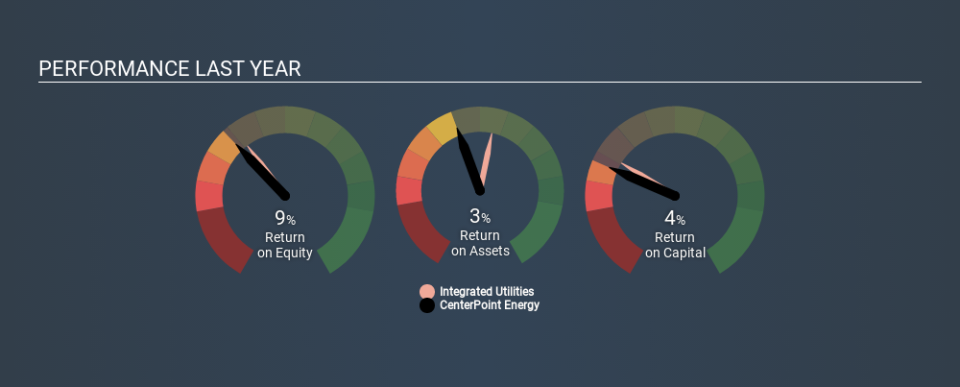What Does CenterPoint Energy, Inc.’s (NYSE:CNP) 4.0% ROCE Say About The Business?

Today we'll look at CenterPoint Energy, Inc. (NYSE:CNP) and reflect on its potential as an investment. In particular, we'll consider its Return On Capital Employed (ROCE), as that can give us insight into how profitably the company is able to employ capital in its business.
First of all, we'll work out how to calculate ROCE. Next, we'll compare it to others in its industry. Last but not least, we'll look at what impact its current liabilities have on its ROCE.
What is Return On Capital Employed (ROCE)?
ROCE measures the 'return' (pre-tax profit) a company generates from capital employed in its business. Generally speaking a higher ROCE is better. Overall, it is a valuable metric that has its flaws. Author Edwin Whiting says to be careful when comparing the ROCE of different businesses, since 'No two businesses are exactly alike.
How Do You Calculate Return On Capital Employed?
The formula for calculating the return on capital employed is:
Return on Capital Employed = Earnings Before Interest and Tax (EBIT) ÷ (Total Assets - Current Liabilities)
Or for CenterPoint Energy:
0.04 = US$1.3b ÷ (US$35b - US$3.4b) (Based on the trailing twelve months to September 2019.)
So, CenterPoint Energy has an ROCE of 4.0%.
View our latest analysis for CenterPoint Energy
Is CenterPoint Energy's ROCE Good?
One way to assess ROCE is to compare similar companies. Using our data, CenterPoint Energy's ROCE appears to be around the 4.9% average of the Integrated Utilities industry. Regardless of how CenterPoint Energy stacks up against its industry, its ROCE in absolute terms is quite low (especially compared to a bank account). Readers may wish to look for more rewarding investments.
You can click on the image below to see (in greater detail) how CenterPoint Energy's past growth compares to other companies.
It is important to remember that ROCE shows past performance, and is not necessarily predictive. Companies in cyclical industries can be difficult to understand using ROCE, as returns typically look high during boom times, and low during busts. ROCE is only a point-in-time measure. Since the future is so important for investors, you should check out our free report on analyst forecasts for CenterPoint Energy.
What Are Current Liabilities, And How Do They Affect CenterPoint Energy's ROCE?
Current liabilities include invoices, such as supplier payments, short-term debt, or a tax bill, that need to be paid within 12 months. Due to the way the ROCE equation works, having large bills due in the near term can make it look as though a company has less capital employed, and thus a higher ROCE than usual. To check the impact of this, we calculate if a company has high current liabilities relative to its total assets.
CenterPoint Energy has current liabilities of US$3.4b and total assets of US$35b. As a result, its current liabilities are equal to approximately 9.9% of its total assets. With barely any current liabilities, there is minimal impact on CenterPoint Energy's admittedly low ROCE.
Our Take On CenterPoint Energy's ROCE
Nevertheless, there are potentially more attractive companies to invest in. You might be able to find a better investment than CenterPoint Energy. If you want a selection of possible winners, check out this free list of interesting companies that trade on a P/E below 20 (but have proven they can grow earnings).
If you like to buy stocks alongside management, then you might just love this free list of companies. (Hint: insiders have been buying them).
If you spot an error that warrants correction, please contact the editor at editorial-team@simplywallst.com. This article by Simply Wall St is general in nature. It does not constitute a recommendation to buy or sell any stock, and does not take account of your objectives, or your financial situation. Simply Wall St has no position in the stocks mentioned.
We aim to bring you long-term focused research analysis driven by fundamental data. Note that our analysis may not factor in the latest price-sensitive company announcements or qualitative material. Thank you for reading.

 Yahoo Movies
Yahoo Movies 

